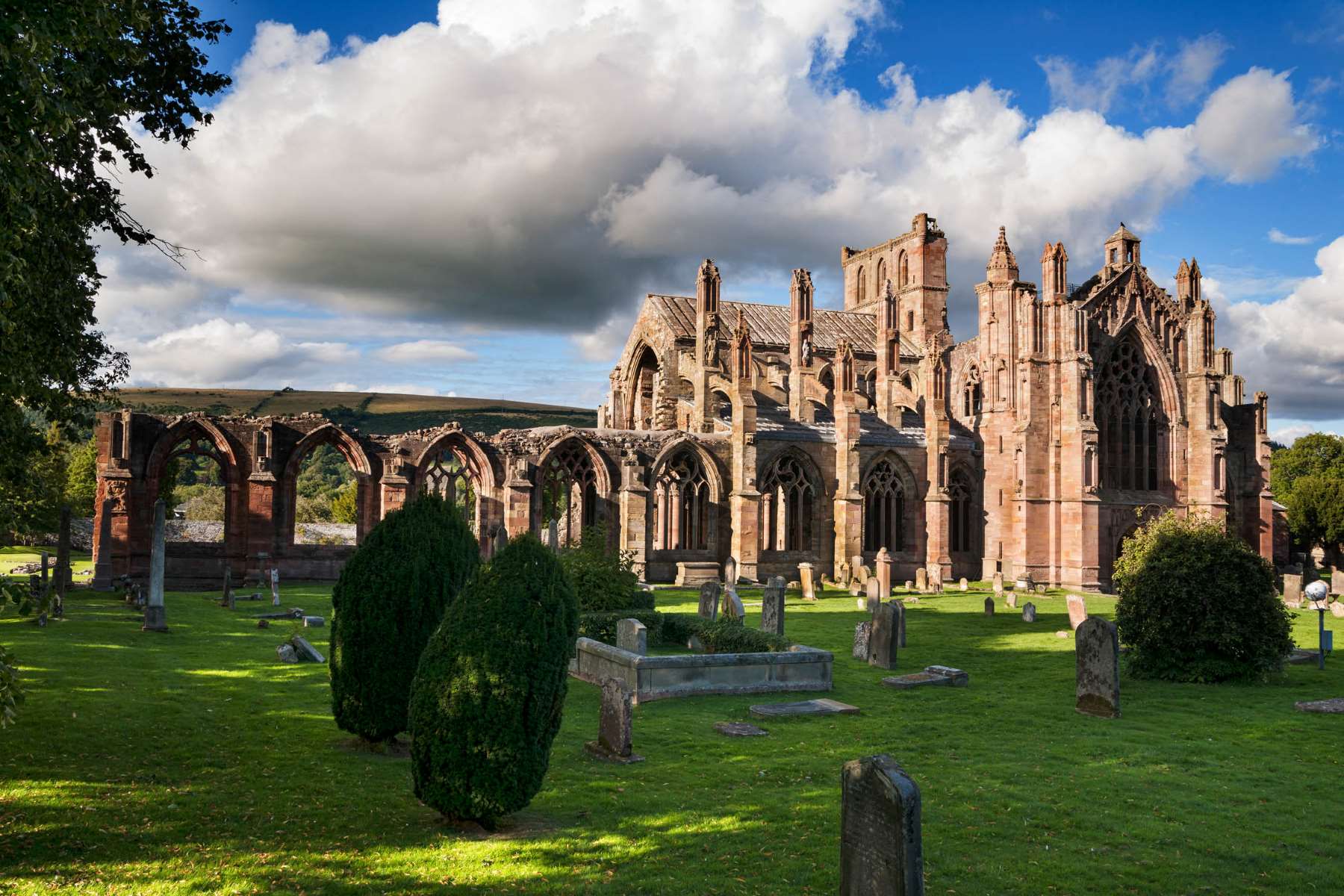
Melrose Abbey is not just another run-of-the-mill historical site. This magnificent landmark, situated in the picturesque Scottish borders, is steeped in rich history and breathtaking architectural beauty. From its medieval origins to its glorious ruins, Melrose Abbey stands as a testament to the past and a testament to human ingenuity. In this article, we will delve into the intriguing world of Melrose Abbey, uncovering 19 astonishing facts that will captivate your imagination and leave you in awe of this iconic landmark. So, fasten your seatbelts and get ready to embark on a journey through time, as we explore the fascinating secrets and stories that lie within the walls of Melrose Abbey.
Key Takeaways:
- Melrose Abbey, a medieval ruin with rich history and legends, is the final resting place of Robert the Bruce’s heart and is believed to hold the Holy Grail, making it a captivating destination for history enthusiasts and curious travelers.
- The abbey’s stunning architecture, haunting legends, and connection to famous figures like Sir Walter Scott make it a timeless testament to a bygone era, offering visitors a chance to immerse themselves in ancient wonders and captivating stories.
Rich Historical Significance
With its origins dating back to 1136, Melrose Abbey has witnessed centuries of historical events, including wars, royal visits, and religious reforms.
Magnificent Architecture
The abbey showcases exquisite architectural features, such as its intricate rose window, graceful arches, and ornate carvings, making it a visual masterpiece.
Final Resting Place
The heart of Robert the Bruce, Scotland’s legendary king, is said to be buried at Melrose Abbey. A plaque marks the spot where it was interred.
Legendary Connection to the Holy Grail
In Arthurian legend, it is believed that Melrose Abbey is the final resting place of the Holy Grail, the sacred cup used by Jesus at the Last Supper.
Monastic Life
The abbey was once home to a thriving monastic community of Cistercian monks who dedicated their lives to prayer, labor, and study.
Royal Patronage
Melrose Abbey received generous support and patronage from several Scottish monarchs, including King David I and King James IV.
Devastating Fire
In 1385, the abbey suffered severe damage during a raid by the army of Richard II of England, resulting in a destructive fire.
Iconic Burial Site
The tombstone of Michael Scot, one of Scotland’s most renowned scholars and philosophers, can be found within the abbey’s grounds.
Hidden Masonic Symbols
It is rumored that Masonic symbols are hidden within the architecture of Melrose Abbey, showcasing the influence of secret societies during its construction.
Spellbinding Setting for Art
The abbey’s picturesque ruins have inspired numerous artists, including J.M.W. Turner, who painted its romantic beauty in breathtaking landscapes.
Haunting Legends
Melrose Abbey is believed to be haunted by the ghost of a monk who was sent to his death by the notorious Wizard of Yarrow during a supernatural duel.
Remarkable Rose Windows
The abbey boasts stunning rose windows, including the lavish “Spanish Tantallon” window, which is revered for its intricate tracery.
Inspiration for Sir Walter Scott
The enchanting beauty and rich history of Melrose Abbey served as a muse for poet and novelist Sir Walter Scott, who immortalized it in his works.
A Survivor of the Reformation
Despite the tumultuous era of the Scottish Reformation, wherein many religious buildings were destroyed, Melrose Abbey survived with parts of its structure intact.
Graffiti From the Past
The walls of the abbey bear fascinating graffiti inscriptions left by visitors dating back centuries, providing a glimpse into the lives of the past.
Tales of Healing Powers
According to local legends, the stones of Melrose Abbey possess healing properties, and pilgrims would touch them in hopes of miraculous cures.
Famous for its Decorative Stone Carvings
The abbey showcases intricate stone carvings, known as “Green Men,” depicting faces surrounded by foliage and symbolizing rebirth and nature.
Borderland Fortress
Due to its proximity to the English border, Melrose Abbey played a significant role during times of conflict, serving as a strategic stronghold.
Timeless Ruins
Today, Melrose Abbey stands as a magnificent testament to a bygone era, its haunting ruins serving as a reminder of the abbey’s enduring legacy.
Visiting Melrose Abbey is like stepping back in time, immersing oneself in a world of ancient wonders and captivating stories. Whether you’re a history enthusiast, an architecture lover, or simply a curious traveler, this remarkable Scottish heritage site is sure to leave a lasting impression.
Conclusion
In conclusion, Melrose Abbey is a truly astonishing landmark that captivates visitors with its rich history and architectural beauty. From its humble beginnings as a monastery to its significant role in Scottish history, the abbey has stood the test of time and continues to be a symbol of Scottish heritage. With its intricate stone carvings, serene surroundings, and fascinating legends, it’s no wonder that Melrose Abbey remains one of the most popular tourist destinations in Scotland. Whether you’re a history enthusiast, a religious pilgrim, or simply someone in awe of stunning architectural marvels, a visit to Melrose Abbey is an experience you won’t soon forget.
FAQs
1. When was Melrose Abbey built?
Melrose Abbey was founded in 1136 by Cistercian monks.
2. How long did it take to construct Melrose Abbey?
The construction of Melrose Abbey took around 50 years to complete.
3. Is Melrose Abbey open to the public?
Yes, Melrose Abbey is open to the public for visits. However, please check the official website for any temporary closures or restrictions.
4. Can I take photographs inside Melrose Abbey?
Photography is allowed inside Melrose Abbey, but tripods and professional equipment may require special permission.
5. Are there guided tours available at Melrose Abbey?
Yes, guided tours are available at Melrose Abbey, providing visitors with detailed insights into the history and architecture of the abbey.
6. Are there any legends or myths associated with Melrose Abbey?
Yes, Melrose Abbey is associated with the legend of the Heart of Robert the Bruce, which is said to be buried here.
7. Can I have a picnic or relax in the grounds of Melrose Abbey?
Yes, there are beautiful grounds surrounding Melrose Abbey where visitors can have picnics or simply relax and soak in the tranquil atmosphere.
8. Can I get married at Melrose Abbey?
Weddings and ceremonies can be held at Melrose Abbey, but it is advised to contact the abbey in advance for specific arrangements.
9. Is there a gift shop or café at Melrose Abbey?
Yes, there is a gift shop where visitors can purchase souvenirs, and a café where they can enjoy refreshments.
10. What other attractions are nearby Melrose Abbey?
Other nearby attractions include Abbotsford House, the former residence of Sir Walter Scott, and the picturesque town of Melrose itself.
If you're captivated by the rich history and stunning architecture of Melrose Abbey, why not explore other fascinating landmarks? Discover the serene beauty of a Cistercian monastery at Lilienfeld Abbey, uncover the mysteries of ancient ruins at Gedi Ruins, or immerse yourself in the vibrant culture and traditions of the Scottish Borders at the Royal Burgh of Peebles Highland Games. Each destination offers a unique glimpse into the past, promising an unforgettable journey through time.
Was this page helpful?
Our commitment to delivering trustworthy and engaging content is at the heart of what we do. Each fact on our site is contributed by real users like you, bringing a wealth of diverse insights and information. To ensure the highest standards of accuracy and reliability, our dedicated editors meticulously review each submission. This process guarantees that the facts we share are not only fascinating but also credible. Trust in our commitment to quality and authenticity as you explore and learn with us.


